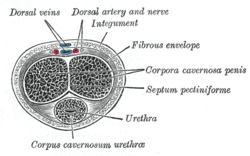Penile fracture
| Penile Fracture | |
|---|---|
 | |
| Penile fracture | |
| Classification and external resources | |
| Specialty | Urology |
| ICD-9-CM | 959.13, 959.14 |
| eMedicine | med/3415 |
Penile fracture is rupture of one or both of the tunica albuginea, the fibrous coverings that envelop the penis's corpora cavernosa. It is caused by rapid blunt force to an erect penis, usually during vaginal intercourse, or aggressive masturbation.[1] It sometimes also involves partial or complete rupture of the urethra or injury to the dorsal nerves, veins and arteries.[2]
Signs and symptoms
A popping or cracking sound, significant pain, swelling, immediate loss of erection leading to flaccidity, and skin hematoma of various sizes are commonly associated with the sexual event.[1][3]
Causes

Penile fracture is a relatively uncommon clinical condition.[4] Vaginal intercourse and aggressive masturbation are the most common causes.[1] A 2014 study of accident and emergency records at three hospitals in Campinas, Brazil, showed that woman on top positions caused the greatest risk with the missionary position being the safest. The research conjectured that when a woman is on top, she usually controls the movement and her entire body weight lands on the erect penis. She is not able to interrupt movement when the penis suffers a misaligned penetration. Conversely, when the man is controlling the movement, he has better chances of stopping the penetration thrusts in response to pain, minimizing harm to himself.[4]
The practice of taqaandan (also taghaandan) also puts men at risk of penile fracture. Taqaandan, which comes from a Kurdish word meaning "to click", involves bending the top part of the erect penis while holding the lower part of the shaft in place, until a click is heard and felt. Taqaandan is said to be painless and has been compared to cracking one's knuckles, but the practice of taqaandan has led to an increase in the prevalence of penile fractures in western Iran.[5] Taqaandan may be performed to achieve detumescence.[6]
Treatment and prognosis
Penile fracture is a medical emergency, and emergency surgical repair is the usual treatment. Delay in seeking treatment increases the complication rate. Non-surgical approaches result in 10–50% complication rates including erectile dysfunction, permanent penile curvature, damage to the urethra and pain during sexual intercourse, while operatively treated patients experience an 11% complication rate.[1][7]
In some cases, retrograde urethrogram may be performed to rule out concurrent urethral injury.[7]
Legal issues
In the United States, the case of Doe v. Moe, 63 Mass. App. Ct. 516, 827 N.E.2d 240 (2005), tested liability for a penile fracture injury caused during sexual intercourse. The court declined to find duty as between two consensual adults. The plaintiff in this case, a man who suffered a fractured penis, complained that the defendant, his ex-girlfriend, had caused his injury while she was on top of him during sexual intercourse. The court ruled in her favor, determining that her conduct was neither legally wanton nor reckless.
References
- 1 2 3 4 Greenberg's Text-Atlas of Emergency Medicine. Lippincott Williams & Wilkins. 22 November 2004. p. 318. ISBN 978-0-7817-4586-4. Retrieved 15 October 2012.
- ↑ Haas CA, Brown SL, Spirnak JP (April 1999). "Penile fracture and testicular rupture". World J Urol. 17 (2): 101–6. doi:10.1007/s003450050114. PMID 10367369.
- ↑ Stein DM, Santucci RA (July 2015). "An update on urotrauma". Current opinion in urology. 25 (4): 323–30. doi:10.1097/MOU.0000000000000184. PMID 26049876.
- 1 2 Mechanisms Predisposing Penile Fracture and Long-Term Outcomes on Erectile and Voiding Functions Advances in Urology, Volume 2014 (2014), Article ID 768158, Leonardo O. Reis, Marcelo Cartapatti, Rafael Marmiroli, Eduardo Jeronimo de Oliveira Júnior, Ricardo Destro Saade, and Adriano Fregonesi.
- ↑ Nuzzo, Regina (9 February 2009). "Preventing penile fractures and Peyronie's disease - latimes.com". Los Angeles Times.
- ↑ Zargooshi J (August 2000). "Penile fracture in Kermanshah, Iran: report of 172 cases". J. Urol. 164 (2): 364–6. doi:10.1016/s0022-5347(05)67361-2. PMID 10893586.
- 1 2 Andrew B. Peitzman; Michael Rhodes; C. William Schwab; Donald M Yealy; Timothy C Fabian (1 September 2007). The trauma manual: trauma and acute care surgery. Lippincott Williams & Wilkins. pp. 305–. ISBN 978-0-7817-6275-5. Retrieved 18 April 2010.
External links
- 2009 Scientific American article featuring interview with Hunter Wessells, chair of the urology department at the University of Washington School of Medicine in Seattle
- The NIH on Treatment options